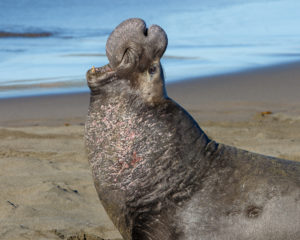Valentine’s Day is right around the corner, and nothing melts the heart like the sight of a newborn marine mammal pup.
How about a thousand of them?
As of January 28, 1,137 pups have been born at the northern elephant seal colony at Ano Nuevo State Park, and another 500 are on the way. But they won’t stay cute and cuddly for long. Although newborn pups can’t swim and depend on their mothers for all their nourishment, they bulk up fast, going from 60 to 300 pounds in a month. At that point, they’re weaned and left to fend for themselves.
Ano Nuevo boasts the largest mainland colony of northern elephant seals in the world, and their naturalist-guided tours provide an up-close and personal window into the daily dramas of the colony, including proboscis-to-proboscis combat between immense males, some of which weigh more than a mid-sized SUV. But Ano Nuevo isn’t the only place to peek at the pinnipeds.
According to Dr. Sarah Allen, scientist at Point Reyes National Seashore, Drake’s Beach is “wall-to-wall flesh” right now. It’s been a good year for the Point Reyes colony. Thanks to the benign weather, mortality has been low among the nearly 700 pups that have been born so far.
Adults return to their breeding grounds in December, but late January to early February is prime time for pups. By Valentine’s Day most of them are weaned, and adult males start vying for eligible females, which come into estrus just as they stop nursing. After mating, the females immediately head for the open ocean, in search of the first meal they’ve had in over a month. The males aren’t far behind. The pups, now called weaners, bask on the beaches for another month or so, teaching themselves to swim and forage, and by late spring most of them are gone, too.
Elephant seals spend most of their lives in the open ocean, some straying as far as Alaska. They almost always return to their natal beaches to breed and molt. The colonies at Ano Nuevo and Point Reyes are so well-established you can see at least a few seals hauled out any time of year.
And sometimes in surprising places. At Point Reyes the seals have been spreading down the beach. According to Allen, visitors occasionally encounter one of the two-and-a-half-ton males in the Drake’s Beach parking lot.
Over-hunting reduced the elephant seal population to an estimated 1,000 individuals in the early 1900s. The population bounced back after hunting was banned, and seals began to return to their former haunts. The first pups were born in the newly forming colony at Ano Nuevo in the mid-1970s.
Tours of the Ano Nuevo colony, which include a three-mile hike, start at 9:00 a.m.; the last one leaves mid-afternoon. The tours are more popular than ever–in fact, many weekends are already sold out–so be sure and book yours early. You can make a reservation by phone (1-800-444-4445) or at anonuevo.reserveamerica.com.
Point Reyes doesn’t offer tours, but you can hike the Chimney Rock Trail at your own pace, peering down into the coves to glimpse the seals. On weekends docents are available at the Elephant Seal Overlook to answer questions. If you go to Point Reyes, be sure to bring binoculars or a spotting scope. After peeping at pinnipeds, turn your gaze to the sea; if you’re lucky you might catch a glimpse of a gray whale in transit.
Early February is a transition time for gray whales, says Izzy Szczepaniak, cetacean biologist with the Oceanic Society. The last of the stragglers (usually the “teenagers”) are heading south to the quiescent lagoons of the Baja peninsula, and the first of the northbound cetaceans are making the trip back to their shallow feeding grounds in the Beaufort and Bering Seas.
- Gray whale breaching north of Half Moon Bay, where the Oceanic Society offers whale watching trips. Photo by Thomas M. Johnson.
Unlike humpback and blue whales, which feed on krill in the midwater, gray whales feed near the bottom, furrowing the ocean floor “like a farmer plowing fields.” This brings amphipods–small crustaceans–into the water column. The whales use their baleen plates to strain out the water and retain the good stuff, which they scrape off with their tongues. Feeding is serious business; the whales require vast energy reserves to fuel the journey to their breeding grounds. The 12,000-mile round-trip may represent the longest migration of any mammal in the world.
The calves and their mothers are the last to leave the breeding grounds. The calves stick close to their mothers for the first year, and for good reason; thanks to the incredibly rich mother’s milk–which Szczepaniak describes as “cottage cheese-like” in consistency–the calves gain weight at a clip of a pound an hour.
Like the elephant seals, the gray whale population is healthy, a heartwarming bit of news among grimmer reports on ocean health. Today the population hovers near 20,000. Point Reyes’s Allen says this may explain the increasing incidence of whale sightings in places like Tomales and Drake’s Bay.
Not content to simply stand on a bluff waiting for a whale to pass by? Consider going to meet them. The Oceanic Society is currently making regular charter trips out of Half-Moon Bay. Szczepaniak says they have seen southbound whales on each of the last three trips. They’ve also seen harbor porpoises, whose recent return to San Francisco Bay has been creating a buzz, and later in the season you can expect to see humpback whales as well.
Trips leave out of Half Moon Bay every Saturday and Sunday (and some Fridays) through May 8. Trips out of San Francisco Bay begin on March 19. To make a reservation, go to the Oceanic Society’s website: www.oceanicsociety.org.

.jpg)




